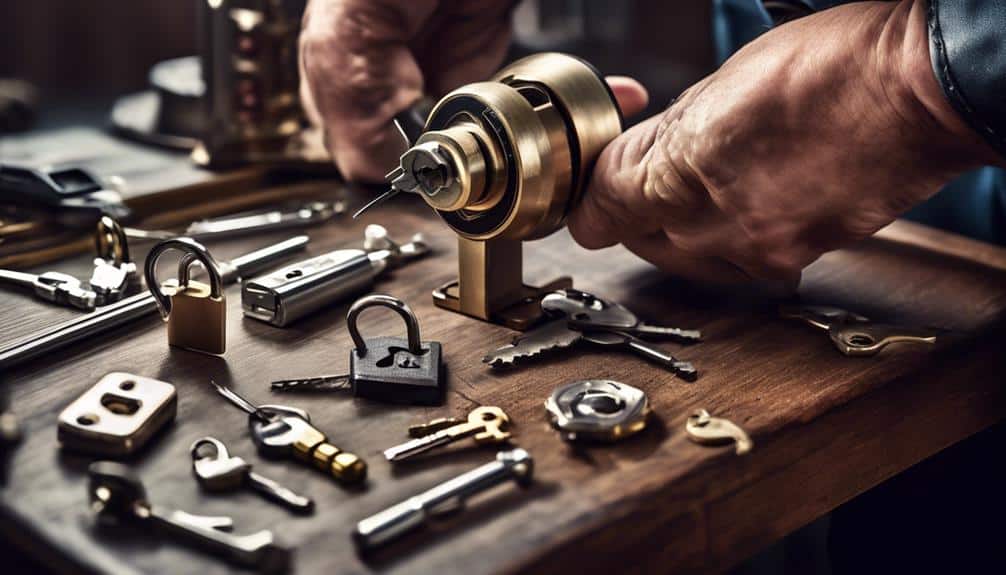If you're thinking that lock repair is a task best left to the professionals, think again. While it's true that some lock issues require the expertise of a locksmith, there are many simple repairs that you can handle on your own.
In fact, with the right tools and a little know-how, you can easily fix most common lock problems in no time. So, before you dismiss the idea of taking matters into your own hands, let's explore 15 essential tips that will empower you to tackle lock repairs with confidence.
You'll be surprised at how simple and rewarding it can be to restore the security and functionality of your locks.
Choose the Right Tools
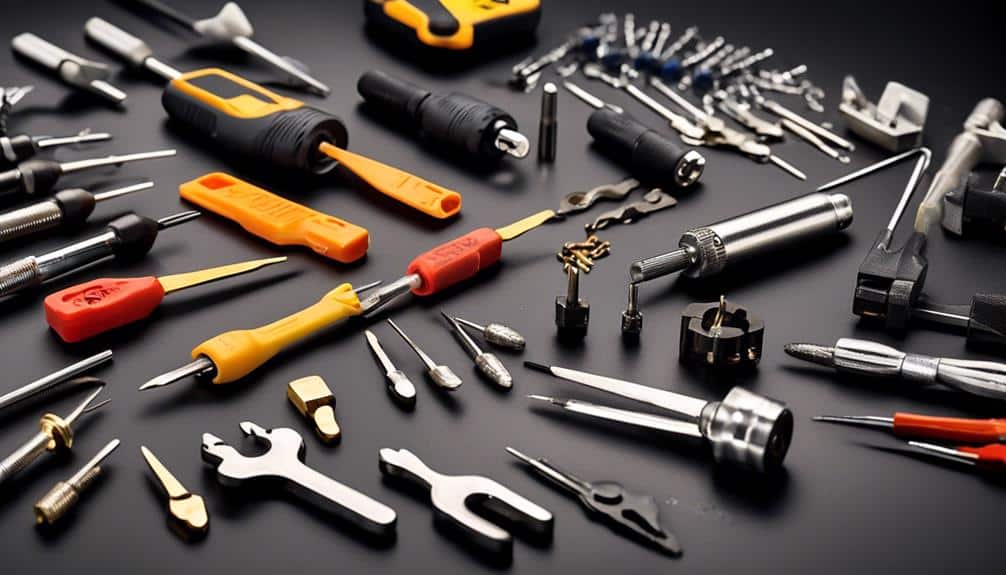
To ensure the successful repair of a safe lock, it's imperative that you carefully select the appropriate tools for the job. Choosing the right tools is essential for a smooth and efficient repair process. When it comes to safe lock repair, precision and accuracy are of utmost importance.
Firstly, you need to have a quality set of lock picking tools. These tools should include a variety of picks, tension wrenches, and key extractors. Each tool serves a specific purpose and allows you to manipulate the lock components with precision. Make sure to choose tools that are suitable for the type of safe lock you're working on, as different locks may require different tools.
In addition to lock picking tools, you may also need some specialized tools such as a drill, a plug spinner, or a scope for inspection. These tools come in handy when dealing with more complex lock mechanisms or when the lock is damaged and requires further examination.
Lastly, proper techniques are crucial when using the selected tools. Familiarize yourself with the correct way to handle each tool to avoid any mishaps or damage to the lock. Practice your technique regularly to improve your skill and efficiency.
Assess the Lock Damage
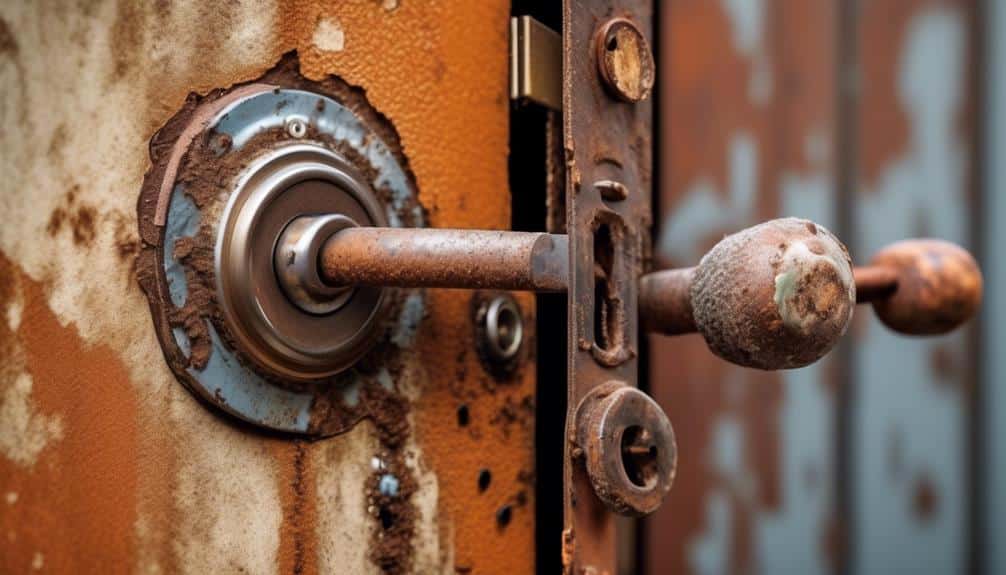
To properly assess the damage to a safe lock, start by conducting a thorough inspection. Look for any visible signs of wear, such as rust, corrosion, or dents.
Next, identify specific repair needs, such as broken springs or malfunctioning tumblers.
Lastly, test the lock's functionality to determine if it's still operational or if further repairs are necessary.
Inspection for Damage
Inspect the lock for any signs of damage, such as broken components or misalignment. Begin by visually examining the lock body, paying close attention to any visible cracks or fractures. Check the keyway for any signs of wear or damage, ensuring the key can easily slide in and out without resistance.
Assess the lock's internal components, including the cylinder, pins, and springs for any signs of damage or corrosion. Examine the latch and strike plate for any signs of wear or misalignment, which can impede proper locking function. Utilize a flashlight to inspect the lock's interior for foreign objects or debris that may hinder its operation.
Ensure the lock's mounting hardware is securely fastened and inspect the surrounding area for any signs of attempted break-ins. Thoroughly documenting any observed damage will aid in accurately addressing the lock repair.
Identifying Repair Needs
When assessing the lock damage, carefully examine all components for any signs of wear, corrosion, or misalignment. This step is crucial in identifying the repair needs and determining the appropriate course of action.
Start by inspecting the keyway for any debris or foreign objects that may be obstructing the key's entry.
Next, check the lock cylinder for any signs of wear, such as scratches or dents. Pay close attention to the pins and springs inside the cylinder, as they may become worn or damaged over time.
Additionally, inspect the lock's latch mechanism for any signs of misalignment or malfunction.
Assessing Lock Functionality
As you continue your assessment of the lock damage, carefully evaluate the overall functionality of the lock to determine the extent of repairs needed. Assessing lock functionality is crucial in troubleshooting common issues and ensuring the lock operates smoothly and securely. Here are some key points to consider during your assessment:
- Examine the key mechanism: Check for any signs of wear or damage on the key and inside the lock cylinder. A misaligned or bent key could cause the lock to malfunction.
- Test the lock's turning mechanism: Ensure the lock turns smoothly and without any resistance. If the lock feels stiff or sticky, it may need lubrication or repair.
- Check for loose or broken parts: Inspect the lock components for any loose screws, broken springs, or damaged bolts. These issues can affect the lock's overall functionality.
- Evaluate the lock's security features: Verify if the lock engages properly and securely. Look for any signs of tampering or forced entry.
- Test the lock in different conditions: Assess how the lock performs in various situations, such as in extreme temperatures or when exposed to moisture. This will help determine if any adjustments or repairs are necessary.
Lubricate the Lock Mechanism
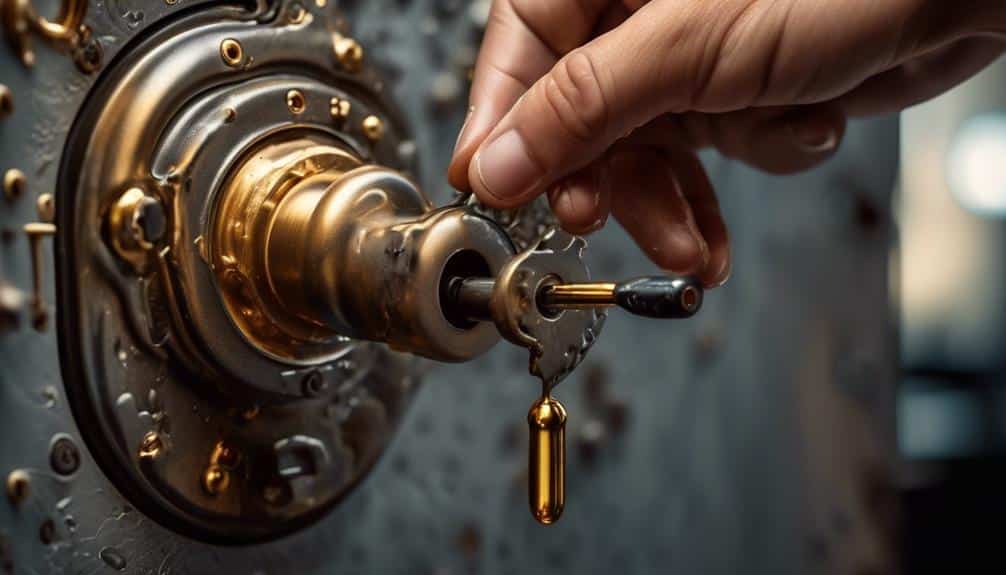
To ensure the smooth operation of the lock mechanism, apply a small amount of lubricant using a precision applicator. Proper lubrication is essential for lock maintenance and can help prevent common lock problems such as sticking, jamming, or difficulty turning the key. By keeping the lock mechanism well-lubricated, you can extend the lifespan of your lock and ensure its optimal functionality.
When choosing a lubricant for your lock, it's important to use one specifically designed for locks or general-purpose lubricants like graphite powder or silicone spray. These lubricants are ideal as they provide long-lasting protection without attracting dust or debris. Avoid using oil-based lubricants as they can leave residue and cause the lock to become sticky over time.
To apply the lubricant, follow these steps:
- Insert the precision applicator into the lock mechanism.
- Apply a small amount of lubricant directly to the keyway or keyhole.
- Gently move the key in and out of the lock to distribute the lubricant evenly.
Remove Obstructions or Debris
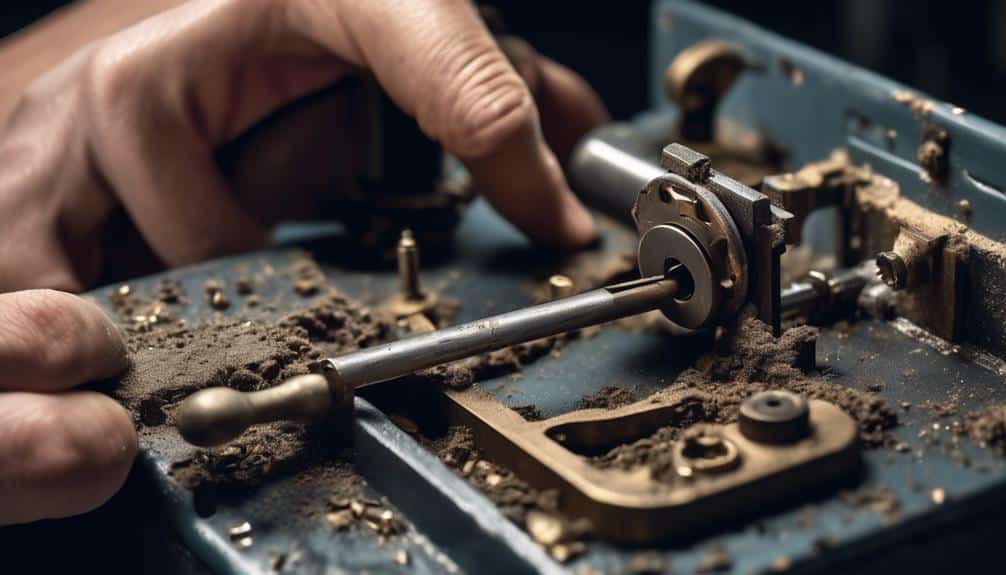
Now, let's move on to addressing potential obstructions or debris that may hinder the smooth operation of your lock mechanism.
To ensure the optimal functioning of your lock, regular lock maintenance is essential. Effective cleaning techniques can help remove any obstructions or debris that may have accumulated over time. Here are some important tips to follow:
- Inspect the lock: Carefully examine the lock to identify any visible obstructions or debris. Look for things like dirt, dust, or small objects that may have found their way into the lock mechanism.
- Use compressed air: If you notice any loose debris, use compressed air to blow it away. This can help dislodge any particles that may be stuck inside the lock.
- Clean with a soft brush: Gently brush the lock mechanism using a soft-bristled brush to remove any remaining debris. Be sure to reach into all the nooks and crannies of the lock.
- Apply a cleaning solution: If the lock is particularly dirty, you can use a mild cleaning solution. Apply the solution to a cloth or a cotton swab and carefully clean the lock mechanism.
- Dry the lock: After cleaning, make sure to thoroughly dry the lock to prevent any moisture from causing further damage or rusting.
Replace Broken or Worn Parts
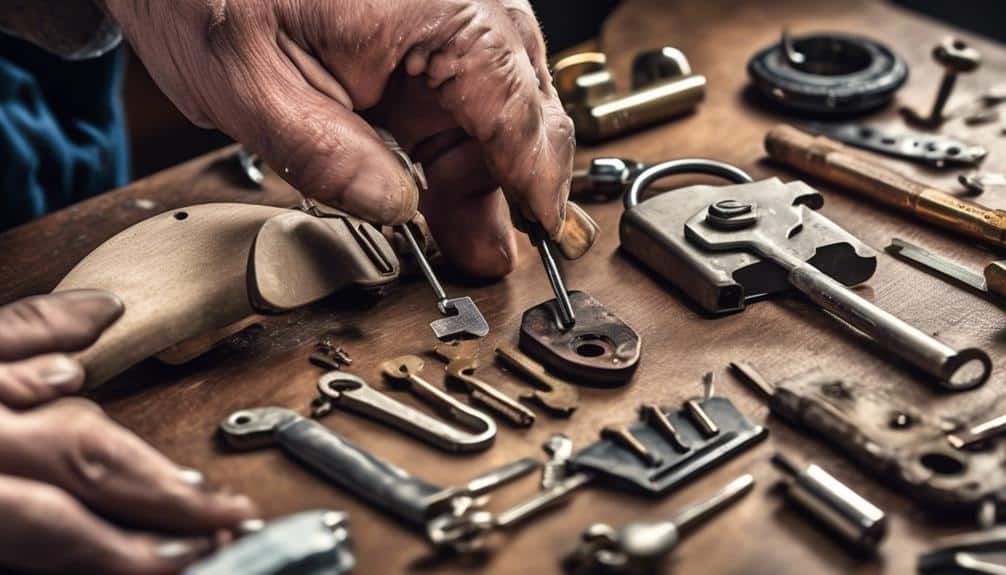
To ensure the optimal functioning of your lock, it may be necessary to replace any broken or worn parts in the lock mechanism. Over time, locks can experience wear and tear due to regular use, exposure to harsh weather conditions, or even attempted break-ins. These factors can cause certain components of the lock to become damaged or worn out, compromising its overall security. It's crucial to promptly replace any broken or worn parts to maintain the integrity of your lock and ensure its effectiveness in protecting your property.
When it comes to lock repair, identifying and replacing broken or worn parts is a critical step. Common parts that may require replacement include springs, pins, tumblers, and the lock cylinder itself. Broken springs can prevent the lock from properly functioning, while worn pins and tumblers can lead to key jamming or difficulty in turning the lock. Additionally, a worn-out lock cylinder can make it easier for unauthorized individuals to pick or manipulate the lock.
To replace broken or worn parts, you may need to disassemble the lock mechanism. Carefully remove the damaged or worn components, and then replace them with new ones that are compatible with your lock model. It's essential to follow the manufacturer's instructions or seek the assistance of a professional locksmith to ensure proper installation.
Realign or Adjust the Lock
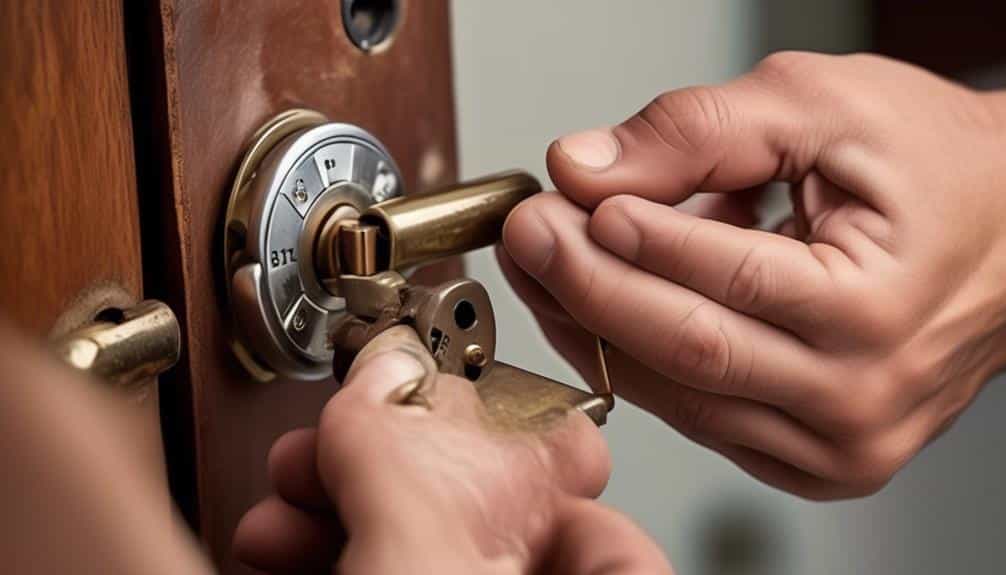
If you have replaced any broken or worn parts in your lock mechanism, the next step is to realign or adjust the lock for optimal performance and security. Proper alignment is crucial to ensure that the lock functions smoothly and effectively.
Follow these essential tips to realign and adjust your lock:
- Inspect the lock mechanism: Carefully examine the lock mechanism to identify any misalignments or irregularities. Look for any bent or loose components that may affect the lock's performance.
- Loosen the screws: Use a screwdriver to loosen the screws holding the lock mechanism in place. Be cautious not to remove the screws completely, as you'll need them to secure the lock after adjustment.
- Realign the lock: Gently manipulate the lock mechanism to align it properly. Make small adjustments until the lock operates smoothly.
- Tighten the screws: Once the lock is aligned, tighten the screws to secure the mechanism in place. Ensure that the screws are snug but not overly tight.
- Test the lock: Before considering the realignment complete, test the lock multiple times to ensure that it operates smoothly and without any issues.
Clean the Lock Surface
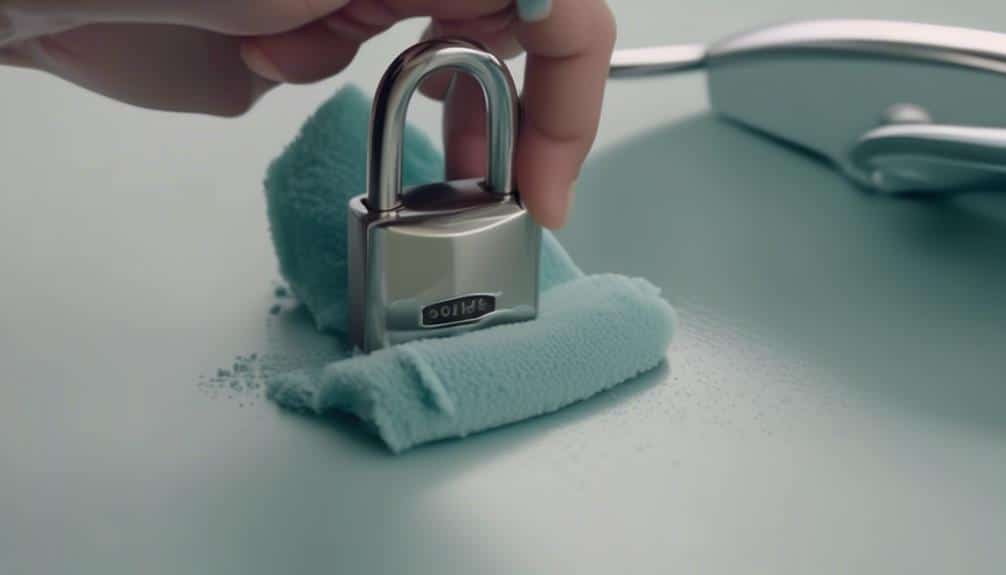
To effectively clean the lock surface, take a soft, lint-free cloth and gently wipe away any dirt, dust, or debris that may have accumulated.
Lock maintenance is crucial for ensuring the smooth operation and longevity of your locks. Over time, locks can become dirty or clogged with debris, hindering their functionality. By regularly cleaning the lock surface, you can prevent these issues and maintain the optimal performance of your lock.
Start by inspecting the lock for any visible dirt or debris. Use the cloth to wipe away any loose particles. Be sure to clean both the exterior and interior surfaces of the lock. Pay close attention to the keyway, as dirt and debris can collect there and affect the key's ability to turn smoothly.
In addition to dirt and dust, locks may also develop rust over time. Rust can cause the lock to become stiff and difficult to operate. To remove rust, you can use a rust remover or a lubricant specifically designed to dissolve rust. Apply the rust remover or lubricant to a cloth and gently rub it onto the affected areas of the lock. Allow it to sit for a few minutes, then wipe away the rust with the cloth.
Test the Lock Functionality
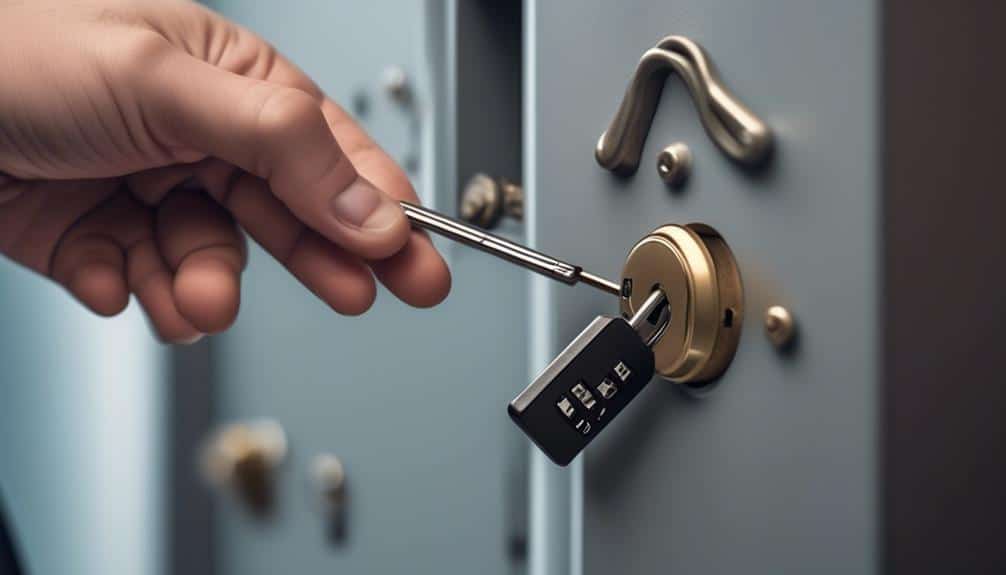
Now, let's evaluate the functionality of the lock. This step is crucial to ensure that the lock is working correctly and can provide the necessary security.
Here are some important tips to help you test the lock durability and troubleshoot any lock issues:
- Insert the key into the lock and turn it in both directions to test the smoothness of the operation. A well-functioning lock should turn easily without any resistance.
- Check if the lock latch or bolt fully extends and retracts when the key is turned. It should move smoothly without sticking or jamming.
- Test the lock with different keys to ensure that it works with all authorized keys. If a key doesn't work smoothly, it may need to be replaced or the lock may require adjustment.
- Try locking and unlocking the door multiple times to assess the lock's reliability. It should consistently engage and disengage without any issues.
- Pay attention to any unusual noises or vibrations during the testing process. These could indicate internal problems that need to be addressed.
Reset or Change the Lock Combination
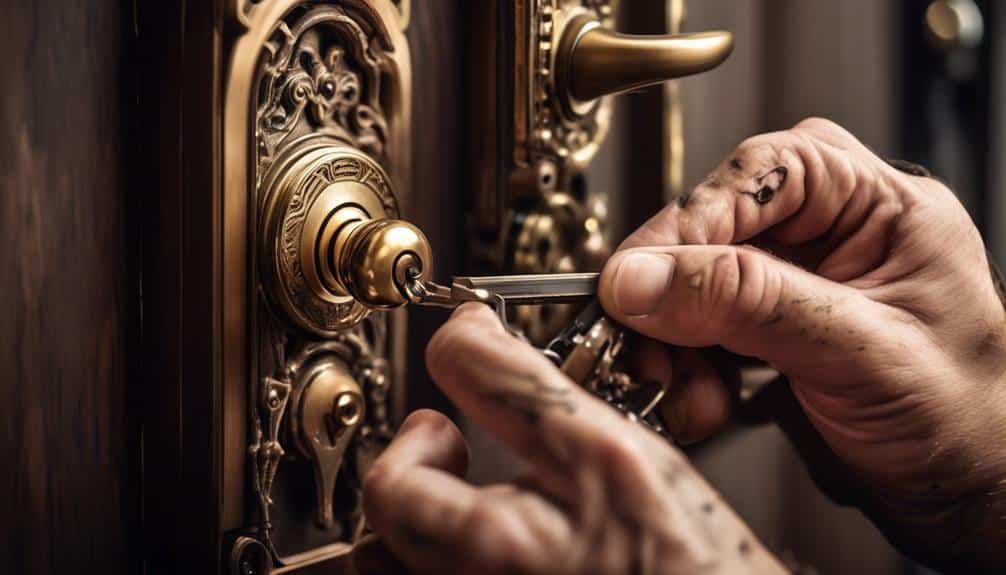
To reset or change the lock combination, follow these precise steps for a technical and experienced approach.
- Start by identifying the type of lock you have and gather the necessary tools, such as a screwdriver or a key change tool provided by the lock manufacturer.
- Next, consult the lock's user manual or contact the manufacturer for specific instructions on how to change the combination.
- In some cases, you may need to remove the lock from the door or disassemble certain parts to access the combination mechanism.
- Once you have gained access, follow the manufacturer's instructions carefully to reset or change the combination.
- After completing the process, test the lock by entering the new combination multiple times to ensure it functions correctly.
- If you encounter any issues during the process, consult the troubleshooting section of the user manual or contact a professional locksmith for assistance.
- Remember to keep the new combination confidential and securely store it to maintain the security of the lock.
Secure the Locking Bolts or Latches
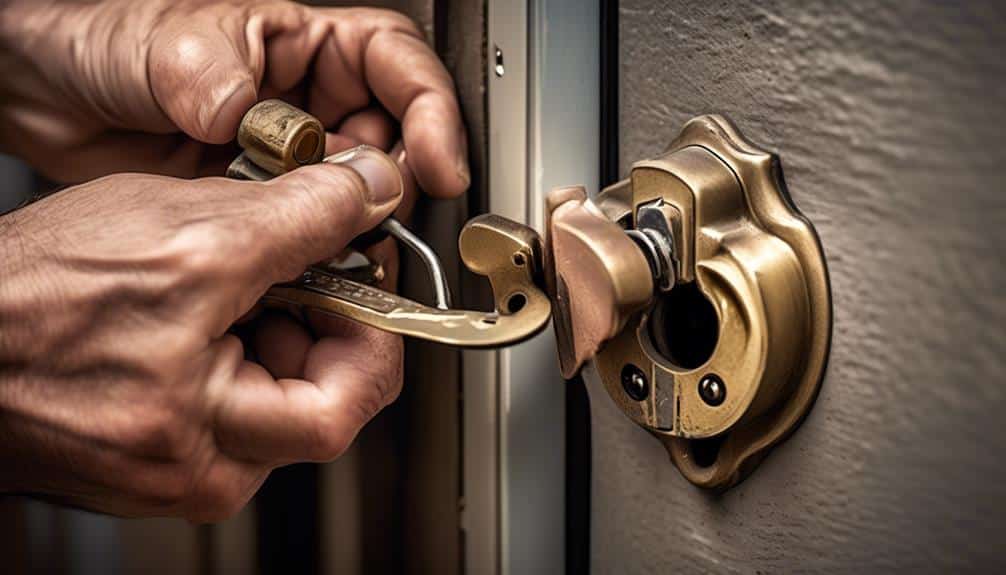
To ensure the security of your safe, it's crucial to properly secure the locking bolts or latches.
One technique is to tighten the bolts using the appropriate tools, ensuring they're firmly in place.
Additionally, regular maintenance of the latches, such as lubricating them, will help ensure their smooth operation and prevent any potential issues.
Bolt Tightening Techniques
Ensure the security of your safe by employing effective bolt tightening techniques for securing the locking bolts or latches. Properly tightened bolts are crucial for the safe's overall strength and resistance to tampering. Here are some essential bolt tightening methods to consider:
- Use a torque wrench to ensure precise and consistent tightening.
- Regularly inspect the bolts for signs of wear or damage.
- Tighten the bolts evenly to distribute the tension evenly across the safe.
- Avoid overtightening, as this can weaken the bolts or cause damage.
- Consider using thread-locking compounds to prevent loosening over time.
Common bolt problems include loose bolts, stripped threads, or worn-out bolts. By using these bolt tightening techniques, you can ensure that your safe's locking mechanism remains secure and reliable.
Regular maintenance and inspections are key to maintaining the integrity of your safe's bolts and latches.
Latch Maintenance Tips
Inspecting and maintaining the latches of your safe is essential for ensuring the security and proper functioning of the locking bolts or latches. By following proper latch maintenance techniques, you can prevent common latch issues and keep your safe in optimal condition.
To begin, regularly check the condition of the latches to ensure they're securely fastened. Loose latches can compromise the safety of your safe and may require latch repair techniques to fix. Additionally, inspect the latch mechanism for any signs of wear or damage. If you notice any issues, it's crucial to address them promptly to avoid further complications.
Furthermore, lubricating the latch mechanism is crucial for smooth operation. Use a high-quality lubricant specifically designed for locks and apply it to the latch and surrounding parts. This will help prevent friction and ensure the latch functions properly.
Enhance Lock Security Features
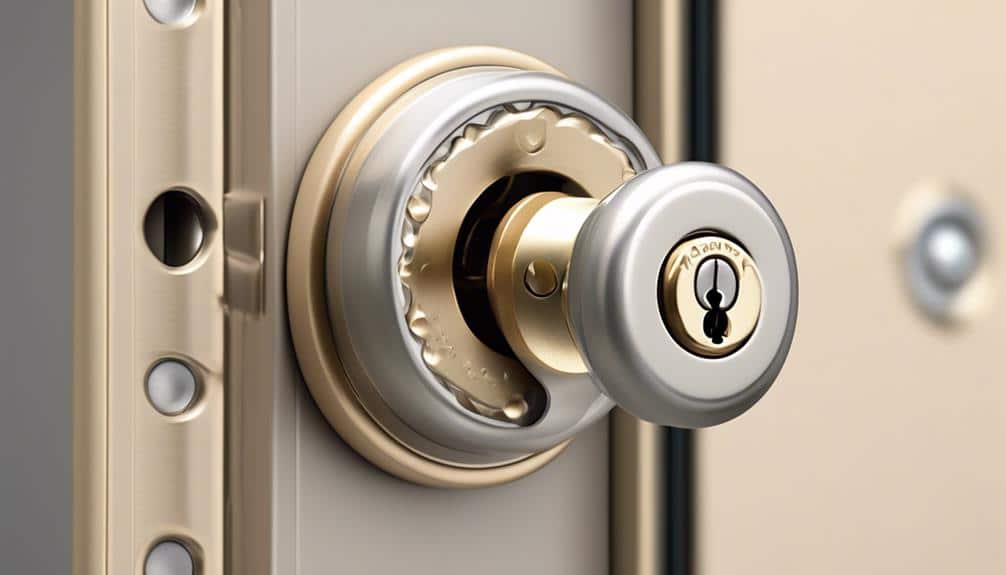
For enhanced lock security features, consider incorporating advanced technology and reinforced materials. By doing so, you can enhance lock durability and improve lock technology, providing you with a robust and reliable security solution. Here are some key considerations to keep in mind:
- Biometric Locks: Utilize fingerprint or iris scanning technology to ensure that only authorized individuals can access your premises. These locks offer a high level of security and are nearly impossible to bypass.
- Smart Locks: Connect your lock to your smartphone or home automation system, allowing you to control access remotely. Smart locks offer convenience and the ability to monitor and manage access to your property in real-time.
- Reinforced Strike Plates: Upgrade your strike plates with heavy-duty metals to prevent forced entry attempts. These plates reinforce the area around the lock, making it more resistant to tampering or kicking.
- Keyless Entry Systems: Replace traditional locks with keyless entry systems that use keypad codes or proximity cards. This eliminates the need for physical keys, reducing the risk of unauthorized key duplication.
- Security Cameras: Install security cameras near your locks to deter potential intruders and capture any suspicious activities. Video surveillance provides valuable evidence in the event of a break-in and enhances overall security.
Install a Reinforcement Plate
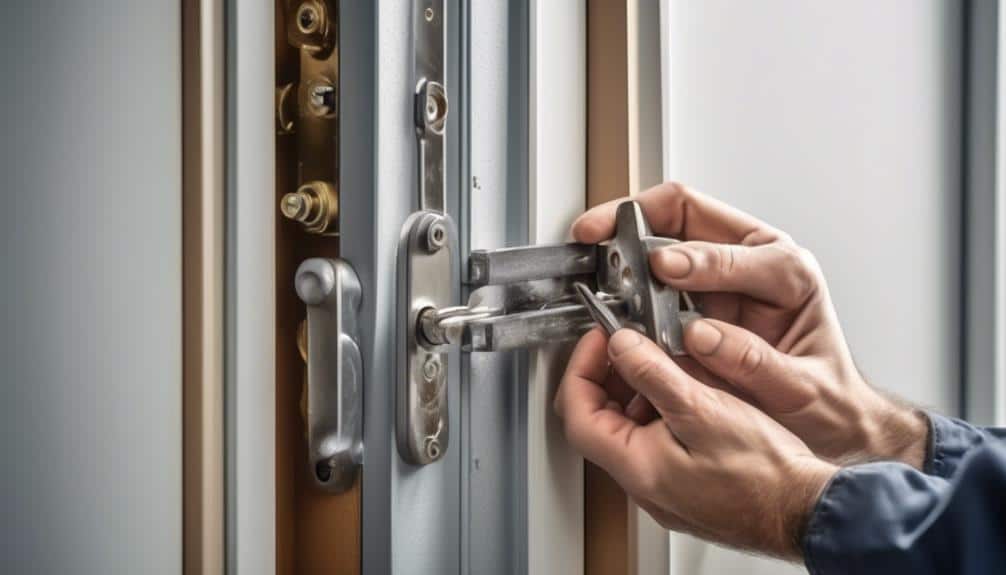
To strengthen the structure of your lock and enhance the security of your door, consider installing a reinforcement plate.
This simple yet effective addition can prevent forced entry and provide an extra layer of protection for your safe.
Strengthen Lock Structure
You can enhance the strength of your lock structure by installing a reinforcement plate. This simple addition can significantly strengthen lock durability and improve lock resistance.
Here are five reasons why installing a reinforcement plate is essential for ensuring the security of your lock:
- Preventing forced entry: A reinforcement plate adds an extra layer of protection, making it harder for intruders to break through.
- Minimizing damage: By distributing the force of an attempted break-in across a larger area, a reinforcement plate helps prevent damage to your lock and door.
- Increasing resistance to drilling: Reinforcement plates are designed to withstand drilling attempts, making it difficult for burglars to gain access.
- Enhancing security: With a reinforcement plate, the lock becomes more secure, providing you with peace of mind and deterring potential break-ins.
- Extending lock lifespan: By strengthening the lock structure, a reinforcement plate helps to increase its lifespan and reduce the need for frequent repairs.
Installing a reinforcement plate is a wise investment that ensures the strength and durability of your lock, providing you with the security you deserve.
Enhance Door Security
Consider reinforcing your door security by installing a reinforcement plate to enhance the strength and durability of your lock. A reinforcement plate is a metal plate that is installed on the doorframe around the lock area, providing additional support and preventing forced entry. It is an effective way to reinforce the doorframe and make it more resistant to break-ins.
In addition to installing a reinforcement plate, you can further enhance your door security by considering the installation of security cameras. Security cameras act as a deterrent, making potential intruders think twice before attempting a break-in. They also provide valuable evidence in case of any suspicious activity or an actual break-in. By combining the installation of a reinforcement plate with security cameras, you can significantly increase the security of your door and protect your home or business from unauthorized access.
Here is a table summarizing the benefits of installing a reinforcement plate and security cameras:
| Reinforcement Plate | Security Cameras |
|---|---|
| Enhances doorframe strength | Acts as a deterrent |
| Prevents forced entry | Provides evidence |
| Increases door security | Enhances overall security |
Prevent Forced Entry
By reinforcing your door security with the installation of a reinforcement plate, you can effectively prevent forced entry and ensure the strength and durability of your lock. This simple yet crucial addition to your door provides an added layer of protection against lock picking techniques and enhances your overall burglary prevention measures.
Here are five reasons why installing a reinforcement plate is essential:
- Improved resistance: The reinforcement plate strengthens the area around the lock, making it more resistant to forced entry attempts.
- Added durability: The plate helps prevent damage to the lock and door, ensuring they remain intact and functional.
- Enhanced peace of mind: Knowing that your door is fortified with a reinforcement plate gives you peace of mind, deterring potential intruders.
- Cost-effective solution: Installing a reinforcement plate is an affordable way to enhance your door security without breaking the bank.
- Easy installation: With minimal effort, you can install a reinforcement plate yourself or seek assistance from a professional for a quick and hassle-free process.
Upgrade to a Digital Lock System
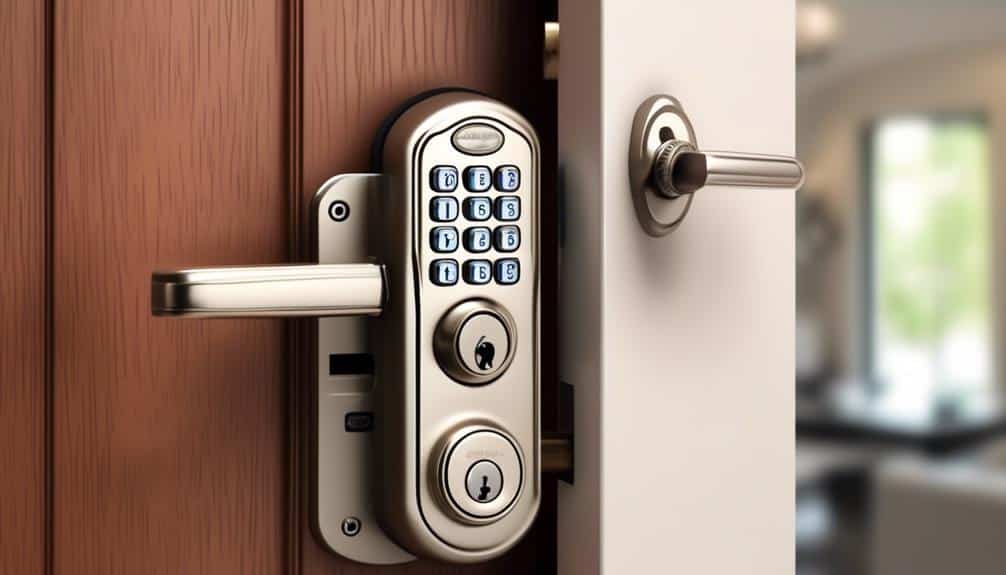
To enhance the security and convenience of your safe, consider upgrading to a digital lock system.
Digital locks offer numerous benefits over traditional key locks, making them a popular choice for safe owners. One of the main advantages of a digital lock is the keyless entry system. With a digital lock, there's no need to worry about losing keys or having them stolen.
Instead, you can simply enter a unique code or use a biometric feature like a fingerprint or retina scan to access your safe. This eliminates the risk of unauthorized individuals gaining access to your valuables.
Additionally, digital locks provide enhanced security features such as multiple user codes, time-delayed access, and audit trails, allowing you to monitor and control who accesses your safe and when.
Furthermore, digital locks are often more durable and resistant to tampering or forced entry attempts compared to traditional locks.
Investing in a digital lock system for your safe is a smart choice to ensure the utmost protection and convenience.
Seek Professional Assistance if Needed
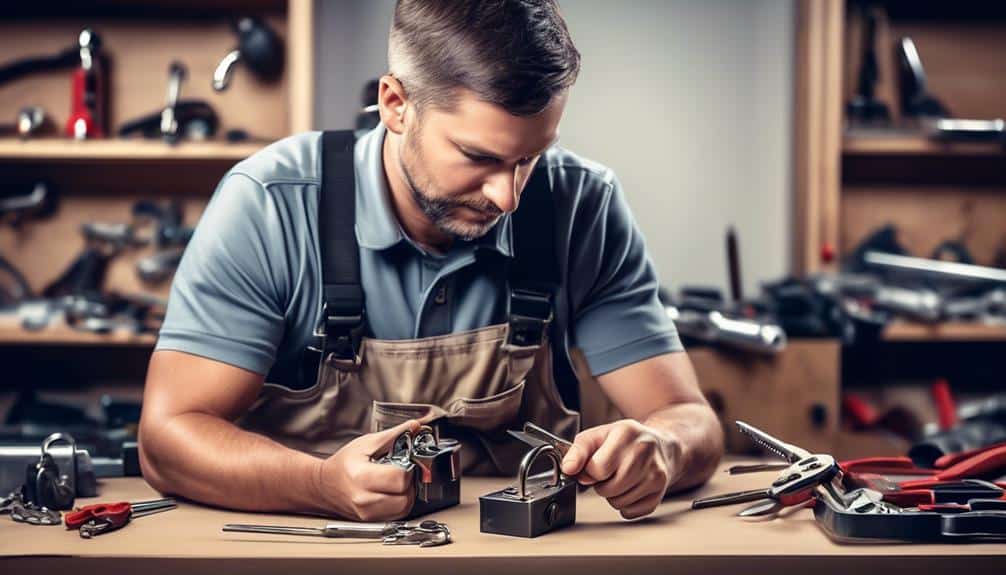
When it comes to complex lock repairs, it's crucial to rely on the expertise of professional locksmiths. They've the knowledge, skills, and experience to handle intricate lock mechanisms and ensure the repair is done correctly.
Knowing when to call in the professionals is essential to avoid causing further damage or compromising the security of your safe. Don't hesitate to seek their assistance when needed.
Expert Locksmiths for Complex Repairs
For complex lock repairs that require specialized expertise, it's highly recommended to seek the assistance of professional locksmiths. These experts have the knowledge, skills, and tools necessary to effectively handle intricate lock mechanisms.
Here are five reasons why relying on expert locksmiths for complex repairs is crucial:
- Precision: Professional locksmiths have honed their skills through years of experience, ensuring precise and accurate repairs.
- Safety: Complex lock repairs can be dangerous, and expert locksmiths are trained to prioritize safety and minimize risks.
- Efficiency: With their expertise, professional locksmiths can quickly diagnose and resolve complex lock issues, saving you time and frustration.
- Guaranteed Results: By hiring an expert locksmith, you can have peace of mind knowing that the repair will be done right the first time.
- Long-Term Solutions: Expert locksmiths not only fix the immediate problem but also provide solutions that prevent future issues, ensuring the longevity of your locks.
When it comes to complex lock repairs, trusting the expertise of professional locksmiths is the smart choice.
When to Call Professionals
If you encounter a lock issue that's beyond your expertise, professional assistance is essential to ensure a secure and efficient resolution.
While DIY lock repair can save you money, there are situations where calling professionals is the wisest choice.
One such situation is when the lock damage is severe or complex. Attempting to fix intricate lock issues without proper knowledge and tools can worsen the problem and lead to higher lock repair costs in the long run.
Additionally, if you lack experience in lock repairs, it's best to leave it to the professionals. They possess the necessary skills and expertise to handle various lock-related problems efficiently and effectively.
Keep a Maintenance Schedule

To effectively maintain the safety and functionality of your safe lock, it's essential to establish and adhere to a regular maintenance schedule. By following a maintenance schedule, you can ensure that your safe lock remains in optimal condition and minimize the risk of any malfunctions or security breaches.
Here are some important maintenance reminders and scheduling tips to help you keep your safe lock in top shape:
- Regularly inspect your safe lock for any signs of wear or damage, such as loose screws, rust, or worn-out parts.
- Clean your safe lock regularly using a soft cloth and a mild cleaning solution to remove dirt, dust, and debris that can affect its performance.
- Lubricate the moving parts of your safe lock with a high-quality lock lubricant to ensure smooth operation and prevent friction or sticking.
- Test your safe lock regularly to ensure its proper functioning, including checking the key or combination mechanism and testing the lock's resistance to tampering.
- Consider hiring a professional locksmith to perform a comprehensive inspection and maintenance of your safe lock at least once a year to identify any potential issues and address them promptly.
Frequently Asked Questions
How Do I Choose the Right Tools for Lock Repair?
To choose the right tools for lock repair, start by considering the type of lock you're working on. Different locks require different tools, such as lock pick sets, tension wrenches, and plug spinners.
It's important to have a variety of tools on hand to tackle any lock repair job. Proper lock maintenance also includes regular lubrication and cleaning.
What Are the Signs That Indicate Lock Damage?
Lock damage can be indicated by several signs. Common causes include wear and tear, improper maintenance, and attempted break-ins.
You may notice difficulty in turning the key, a loose or wobbly lock, or the lock not aligning properly with the strike plate.
To prevent lock damage, ensure regular lubrication, avoid using excessive force when operating the lock, and consider installing security features like deadbolts.
Promptly addressing any signs of damage can help maintain the security of your property.
How Often Should I Lubricate the Lock Mechanism?
To keep your lock mechanism working smoothly, regular lock lubrication is essential. Without proper lubrication, the lock may become stiff or difficult to turn. By regularly maintaining your lock with lubrication, you can prevent potential damage and extend the lifespan of the lock.
It's recommended to lubricate the lock every six months or whenever you notice any signs of resistance. This simple maintenance step will ensure the continued functionality and security of your lock.
How Do I Remove Obstructions or Debris From a Lock?
To remove obstructions or debris from a lock, start by inserting a thin, sturdy wire into the keyhole.
Gently wiggle the wire to dislodge any debris.
Alternatively, you can use compressed air to blow away the obstructions.
Be careful not to force the wire or use excessive pressure, as this can damage the lock mechanism.
Regular lock maintenance and preventing lock damage are crucial for ensuring optimal performance and security.
When Should I Seek Professional Assistance for Lock Repair?
If you're not familiar with lock repair, it's best to seek professional assistance. Trying to fix a lock yourself can lead to common mistakes, like damaging the lock further or making it ineffective.
DIY lock repair may seem cost-effective, but it lacks the expertise and tools that professional locksmith services offer. Trusting a professional ensures the job is done right the first time, saving you time, money, and potential security risks.

